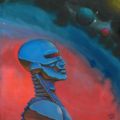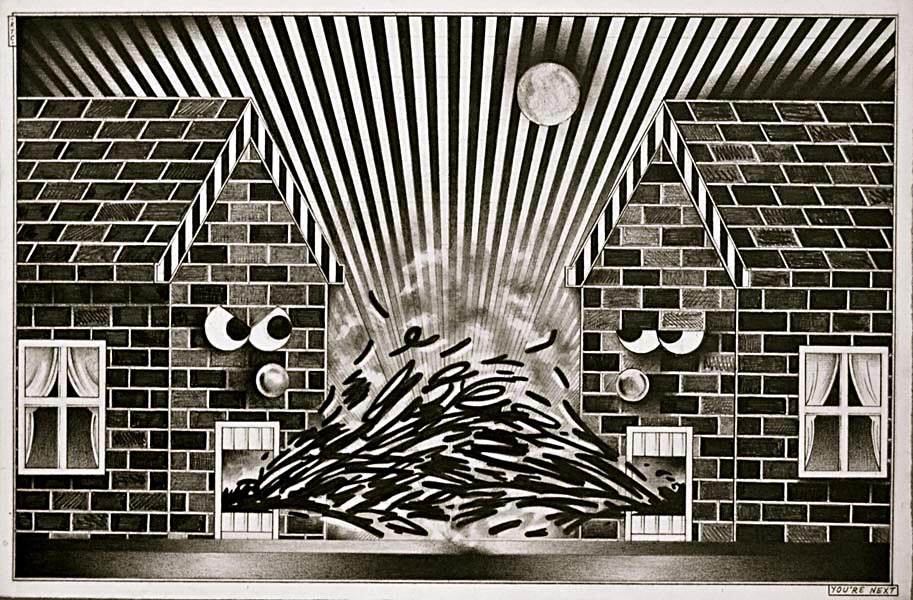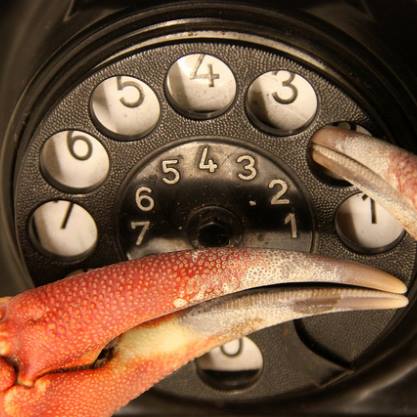
Posthuman run through the making of their latest LP “Mutant City Acid”
For the uninitiated, Posthuman are cousins Joshu Doherty and Rich Bevan – one of the leading production, DJ and party starting outfits who have been spearheading an acid-tinged revival here in the UK over the last decade, courtesy of their dedication to the sound and boundless energy. Whilst their output as recording artists has evolved over the years, from their early Electronica releases to their current 303 driven house & techno sounds.
They’ve spent the last 10 years amassing a large body of work, which culminated in the release of their 5th album “Mutant City Acid” at the end of 2018 on their Balkan Vinyl imprint. In all, the album took them over three years to complete: a slow-burner of a project which bubbled away and took shape in the background alongside other projects.
As Doherty explains: “ ‘Nightride to New Reno’ and ‘Damocles Syndicate’ really were the starting point of this project as they were both born from the same session. Also, the ‘Mutant City Acid’ series of 12’s on Balkan inspired the artwork direction (and ultimately the name). It was a chance to dive a lot deeper into that world. Computer games like Flashback, Syndicate, The Dig, Beneath a Steel Sky, Streets of Rage etc worked as a bed of imagery and sounds, but influences have also been taken from books, TV, movies and games – and even real life places like Kowloon City. We wanted an album that would work as a complete piece, a journey that could be listened to in a single sitting, pair of headphones on in the dark, eyes closed, that would transport the listener. The defining albums of our teenage years felt like this: U.F.Orb, Public Energy No.1, Landcruising, Lifeforms etc. Our earlier material was more of this ilk – so it was about finding the connecting pieces between that, and our current love affair with acid and the dance floor. In this digital age of throwaway music, instant gratification and lack of focus, it was important to make a physical product that could move back to those earlier days – beautiful unique coloured vinyl, detailed artwork across a gatefold sleeve, the tube map and classified adverts – so you can really engage various your senses.”
With this in mind, here’s what they had to say about the making of each track on the LP:
Into Gestalt
“The idea of Gestalt is similar (though not identical) to Apophenia – the concept of structure and patterns built from chaos – to turn entropy into organisation. It translates literally to Form. This is what a city is – a construct, where all the individual lives and structures combine to create a sense of identity. Apophenia is more the illusion of patterns within chaos – but how can someone say that a city has it’s own personality when it is in itself an ethereal, ever-changing illusion that only exists in the mind? …so it’s possible they have more in common than we think. The track is also a statement of intent for the album. It’s an acid techno album, a driving journey – but with more obscure details hidden in the mix, and it deliberately collapses into nothing, just distant echoes. Like all cities do, eventually.”
Nightride to New Reno
“This was written alongside another track ‘The Damocles Syndicate’ which was actually released on Shipwrec earlier in 2018, it’s a companion piece to the album – or even an extended part of. Both were the first tracks written and put aside as we decided ‘this is what the album would be’ in early 2015.
‘Nightride…’ features recordings from the underground subways of New York, London, and Moscow. We wanted the track to slowly emerge from the noise – like when you first get on an underground train: it’s all crazy and noisy but after you get used to it, you start hearing patterns and rhythms – the clacking of rails, random bleeps of alarms. The main riff is played on our Yamaha DX21 – the first synth I ever owned – and was restrained to occur just the once – no repeats – almost more a coda than leading melody. Think on how when you’re travelling on train by night and suddenly there will be a single noise, a flash of light, as you pass by an event or building or huge neon billboard: then just as suddenly as it appeared, it’s gone.”
‘Damocles…’ was built out of the sounds of two computer games: Syndicate, and Damocles (also known as Mercenary”). Both games really influenced the artwork and atmosphere behind the album, retro-futurist graphics and depictions of weird near-future dystopias full of criminal organisations and political wrangling (is there a difference?).”
Once Was
“The thing about change – or decline – is it’s nearly always piecemeal and you don’t notice the incremental steps, until you look back and see how far you have gone. Everything once was something else. This track is called ‘Once Was’ because it once was a track called Moment of Weakness, from the Seed Records Volume One compilation in 2003. All that remains is the original pads, everything else has been dismembered and rebuilt into an entirely new track. There’s a few moments in the album that are stolen (borrowed!) from older tracks, as we wanted to find the connections from those days to our current work.”
Gods of Technology
“This was named after a voice sample that actually ended up cut from the final version – pinched from Alpha Centauri (a computer game from the early 90’s) where a faction leader talked about hanging huge weight from greater-than-tensile-steel strength cables made from genetically engineered spiders web. It’s centred around the TR-08, which is a great digital TR808 clone except for some weird phasing on the kick if the decay is pushed to maximum. The 303 line shifts it’s starting point as the track progresses, giving a subtle change in rhythm for the latter half. Pads are samples from my old Juno 6, which sadly got sold a few years back but I kept a collection of sounds before sending it on it’s way.”
Junk Bonds
“Junk Bonds, the high risk go-to for the desperate. Corporate greed meets public need, a perfect example of how it’s always the poor who suffer when they try to play the game of the wealthy – be it 1929, 2008, or onwards forever. Originally there was a different version of this track, a little more driven and dancefloor aimed, which was given to a label who promised a release but then sat on it for a year. A remix came out on a compilation but the track itself never saw the light of day, the label finally admitted nothing would happen, and it was reclaimed. Timothy ‘Heretic’ Clerkin kept pestering me to get it put out on vinyl, so we rebuilt it – a bit grungier and more soaked in reverb, to fit with the collection that – by this point – was starting to form the album.”
Raid on Kyoto Quarter
“The spoken word piece in this track is written and performed by The Strangest Pet on Earth – our oldest collaborator and friend Bruce McClure. Bruce was the co-founder of our first label Seed, our resident & tour DJ in the early years of Posthuman. He’s Richard’s closest oldest friend, we’ve all known each other getting on over 25 years now. Bruce’s spoken word pieces appear across our music regularly, going right back to 2000 with our first “Posthuman” demo CDs featuring a track literally called “Bruce Monster”. This particular story sums up the dead, dusty dystopia of the Badlands on the edge of Los Angeles. The vinyl version of this album is more dancefloor related, while the cassette version “Mutant City Stories” focuses more on ambient and beatless version, with the exception of this track – the heavier rhythmic take is on the cassette. There’s also another of Bruce’s short spoken pieces on the cassette, un-named.”
Shellworld Industries
“Another 808-303-Juno combo track. Honestly it’d be a challenge to do something badly with that magic trio. The little stabs are from the JU-06, another of the boutique digital clones – they were pretty heavily used throughout the album (TR-09, SH-01A as well). The name is taken from an Ian M Banks novel, where planets have been hollowed out and built into multiple layers, called Shellworlds. No-one knows when, how or why they were made, but there are plenty who want to take advantage and exploit them.”
Abaskun Control
“Abaskun is a lost city, thought to be a port on the Caspian Sea and either destroyed or sunk beneath the waves – except nobody really knows who may have sacked it, or how it fell into decay. But it isn’t a mythical place; it definitely existed, once. This track is comprised of three other incomplete tracks, built together. The beats were from a track simply called “Test A1” and the background noises from a piece called “Winds”, which we wrote back in around 2001. The 303 line is taken from an untitled track, and slowed right down to fit with the slow shuffle.”
Transit System Error
“Like ‘Nightride…’ this is a track designed for that moving, shuffling, driving feel. Loops as lights and bridges and buildings slip past. Slow flanges and clanks of drums from the 707, and CR78 (sampled, sadly) and a doubled 303 line. Chris Cunningham’s triple-screen video mix of Gil-Scott Heron’s ‘New York Is Killing Me’ was a big inspiration behind this track.”
Wishmountain
“Empty promises of salvation and redemption pile up in our lives, a mountain of wishes. You can travel to Lotus Island, battle your demons, and climb the mountain – but in the end you have to return to reality. Nothing last forever.”




